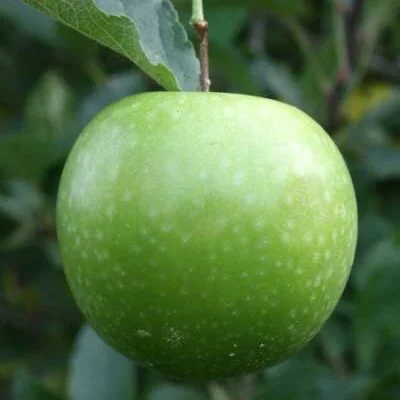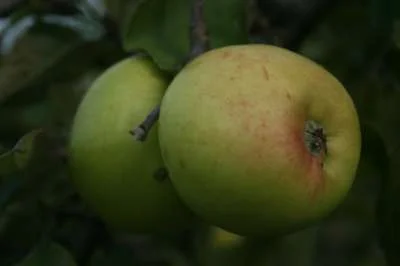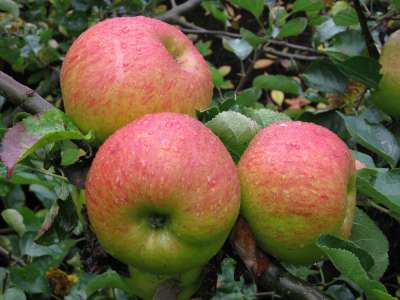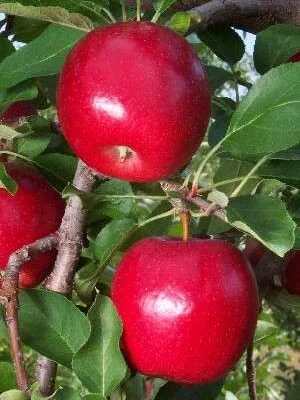Your basket is currently empty!
A Guide to Growing Cox’s Orange Apple Trees in Your Garden
So, like so many of us when asked what your favourite apple is the answer just has to be that Great British classic ‘Cox’s Orange Pippin’ Even after all these years the flavour remains incomparable; that perfect balance of sweetness, acidity and deep, evocative aromatic flavour just has no compare.
Very likely you would like to grow this variety in your garden – many gardeners do. And also very likely, unless you want to put a lot of time and effort in, you will be disappointed. You see, this is not a variety to take on lightly. It isn’t easy to grow well. Commercial samples you see in the supermarkets might look perfect but they didn’t happen that way without a lot of input and professional growing know-how. It’s great Achilles heel is it’s susceptibility to all types of disease. Scab – that scourge of leaf and fruit. Mildew aplenty, covering the new growths in a thick silvery powder. Rosy apple aphids will densely infest and stunt it’s new growths. And bitter pit can mar seemingly perfect fruits with bitter tasting internal blemishes. Oh and it has a great tendency to every other year cropping too, meaning alternate years it is almost barren of fruit. Apart from that – it’s fine!
Happily, though you can pursue your dream of growing perfect Cox apples in your garden, with a little know how.
If you still insist on the real mc coy – a genuine Cox’s Orange Apple tree for your garden – then follow this guide. However what I really recommend you do is make a selection from my top ten Cox type apple varieties, which are not the original Cox’s Orange Pippin, but which were bred from it. These tasty apples have more than a smidgeon of real Cox flavour, they all feature Cox as one parent in their DNA, but they are a whole lot easier to grow and make more satisfactory garden apples!
Growing real Cox’s Orange Pippins
To keep diseases at bay you must spray with a good fungicide. Organic growers take note, this is non-negotiable. To grow Cox’s Orange without chemical input is a waste of time. And talking of time, this is everything. Never has the saying ‘prevention is better than cure’ been more true. You need to start applying a good fungicide like Provanto early in the season, from soon after the leaves emerge. This will help protect it from mildew, scab and other diseases. Be sure to remain fastidious and repeat the application as per the guidance on the back of the bottle. If you wait until the first fungal infections make an appearance and take hold you will be on the back foot for the rest of the season.
And to safeguard against aphids and other bugs intermittently use a systemic insecticide such as Provado –similar name to the fungicide I have recommended, Provanto.
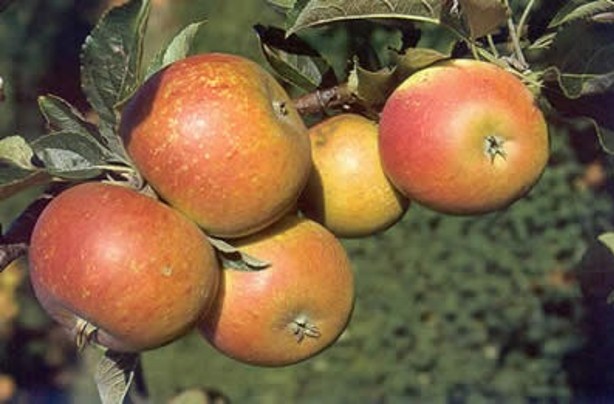
Be generous and treat it kindly
A strong foundation of happy abundant growth will be more likely to fight off diseases. So make sure the soil is well cultivated before you plant and has no competition from weeds and neighbouring plants. A good application of compost and a general purpose fertilizer like bonemeal will pay dividends. Keep the tree growing strongly the first season by making sure it never gets too dry or stressed. It’s first summer is crucial to maintaining momentum.
Make sure you prune for a fairly open habit, as congested growth is more likely to suffer from disease. And if you appear to have an overabundance of blossom and fruit set be prepared to thin it out after the traditional June drop period, if after this time the tree seems to be overproducing, thin out some of the fruits. This will make sure the tree does not exhaust itself and spend the next year resting with little or no fruits at all.
As the tree begins to mature, be sure to mulch well with manure or compost. This helps make sure the apple tree does not get so stressed during dry periods and will also help keep weeds down which could otherwise start to compete with the tree for available moisture and nutrients. Mulching also protects the roots from frost.
Growing forms for Cox’s Orange
Happily, this variety is a spur bearer. This makes it suitable for all kinds of growing methods. You can place it against a wall and train it as a fan or espalier, as long as you have a space of not less than 2 metres across and high. And you can also grow it as a cordon or column – these tree types are easy to grow and prune, and very space saving. Or you can treat it as a traditional bush tree in the varying root stock sizes available, from larger orchard and paddock sized trees, right down to smaller dwarfing ones for the small garden. Growing Cox’s Orange in a container is quite a simple matter too – a 20 litre capacity container is ideal for the small miniature ‘M27’ stock tree. Use a loam based compost for any fruit tree to be grown in a container.
Pollination for Cox’s Orange apples
Another thing to remember with this variety – it isn’t self fertile. So it will need another tree to go with it to make sure it sets fruit. This should be a different variety that flowers at approximately the same time. The list of candidates is quite long. Traditional favourites like James Grieve, Laxton Superb or Discovery are often used. And most of those contained in my Cox replacement list below will also do the job. One attribute of it’s own that Cox’s Orange Pippin does have is that it has plenty of viable pollen and will reciprocate other varieties and help them to set fruit as well.
Great tasting Cox type apple varieties for your garden.
So here we go – here’s my top ten super tasty Cox like apple varieties that will do well for you [almost] no matter what!
10 Charles Ross
A very popular garden tree that may need no introduction to some. It was raised in Berkshire in around 1890 and was soon winning awards from the RHS. It is a large and often strikingly red hued apple with a fairly soft flesh and a juicy pleasant Cox type flavour., For use from mid September onwards, so earlier than Cox. Pollinated by most mid season flowering varieties.
A real old timer first introduced in 1893 from Maidstone in Kent, and which seems to be finding favour again now. The richly aromatic flavour unmistakeably hints at some Cox’s Orange in it’s ancestry. It should not be harvested too early to allow the flavour to develop fully – November is soon enough. It will then keep well into the new year. The fruits are greenish yellow with a rusty red flush and some russet patches. Quite firm yellowish flesh. Pollinates with earlier flowering varieties like Idared, Beauty of Bath and Lord Lambourne.
New Zealand Raised in the early 1900’s. Although not known as the most attractive of apples that doesn’t matter when flavour is the priority, and this apple wins every time when it comes to taste.. A free spurring tree which makes it ideal for cordon and espalier training, the season is November-February, the creamy white flesh is crisp and not floury.
This Devon raised beauty is well worth growing because it’s season starts in September, well before traditional Cox’s. The fruits should be used quite quickly to enjoy them at their best whereupon the evocative, complex flavour characteristics will win you over. A moderately vigorous easy to grow tree. Pollinates well with Sunset, Kidds Orange, Charles Ross, Laxton Superb and Greensleeves.
6 Holstein
Not very well know but sought after by those ‘who know’ and usually does well in flavour testing. The fruits can be quite large, and are firm with a deep rich aromatic quality to every bite. Season November-January; a vigorous grower which does best with a couple of other varieties to pollinate fully. Capable of heavy yields and it’s vigour usually enables it to shrug off disease.
For picking in early October and use until December. Popular all over the continent and in America too, this is always a good doer with a flavour which compares favourably to Cox. Pollinates well with Cox itself as well as Pitmaston Pineapple, Katy, Greensleeves and Red Devil. Very cold hardy so good for the North too.
Raised in Bedford in 1922, one parent of which is Cox’s Orange. The influence is obvious from the sensationally flavoured creamy flesh. An angular, vigorous well branched tree, the only fault is it’s over exuberance. The fruits are pale green, usually more than half covered by a deep red flush. Flowers a little after Cox’s Orange, pollinate with Pixie, Charles Ross, American Mother etc.
3 Suntan
Never an especially popular variety but deserves more recognition. A vigorous grower, so best tempered with a small rootstock like M27 or M9, on which results can be spectacular with large firm tangy fruits blessed with a fine flavour [one parent was Cox’s] and a jolly red flush. For harvest in November, stores until February whereupon the flavour becomes milder and sweeter. A very good cropper with large, attractive blossom and good disease resistance. Pollinate with a pair of late flowering varieties like Spartan, Pixie, Gloster, American Mother etc.
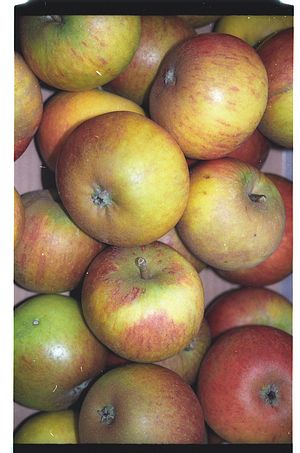
2 Fortune
Syn Laxtons Fortune. Often known as the ‘early Cox’ because of the fine sub-aromatic sweet flavour of this early maturing variety which can be enjoyed in September. This Bedford raised variety was released in 1931 and quickly became a favourite garden apple. A compact grower and good yielder with cream-white inner flesh. Pollinates well with James Grieve, Discovery, Cox, Greensleeves, Worcester Pearmain etc. The fruit are pale green to yellow with a slight red flush on the sunny side.
1 Sunset
A Cox seedling with a long and distinguished award winning past. First named in 1933 whilst it never attained commercial popularity, the fruits being too small, it’s future was secured by becoming a popular garden variety of it’s day, a position it still holds. It’s virtues are it’s easy growth, superb Cox type flavour, hardiness and long eating period; you can enjoy Sunset from late September to Christmas. Top rated Cox type apple for garden growing – highly recommended. A great little tree. Pollinates well with James Grieve, Discovery, Saturn, Fortune, Merton Knave, Fiesta, Bountiful etc, and is also a good pollinator for other varieties.
Honourable mentions to – Fiesta, Jupiter, Blenheim Orange, Woolbrook Pippin.
6 tips for growing Cox’s Orange Pippin well:
- Avoid high nitrogen fertilizers
- Prune for an open shape
- Mulch annually
- Maintain regular fungicide coverage
- Provide adequate pollinating partners
- Keep aphids at bay with an insecticide



